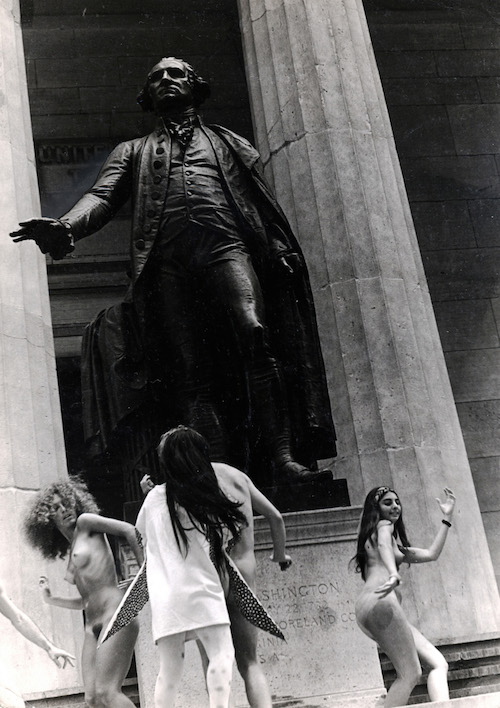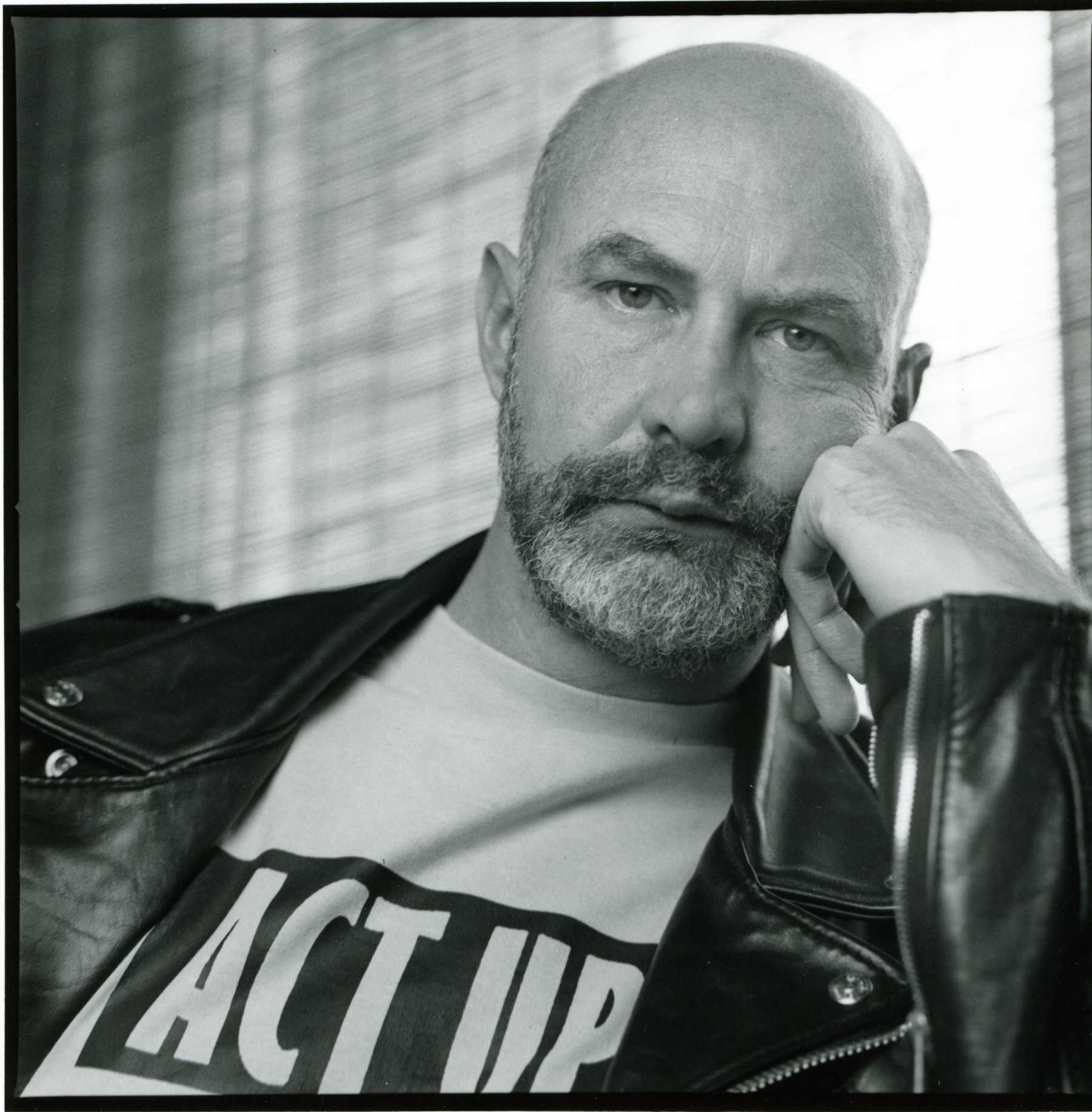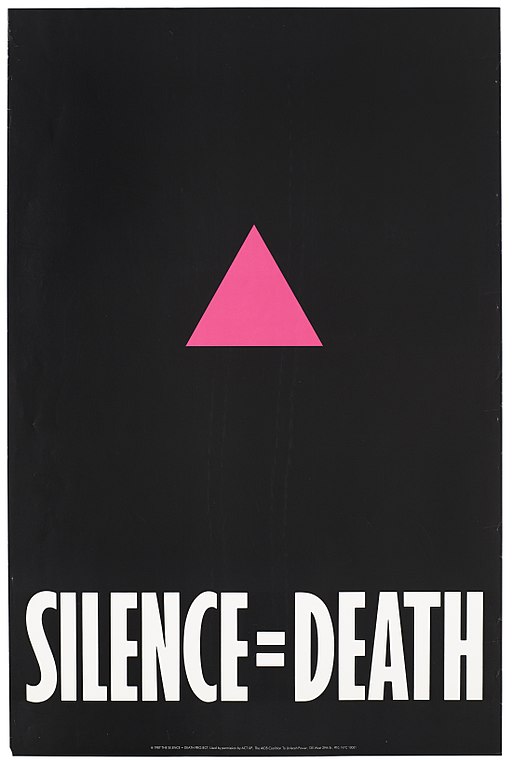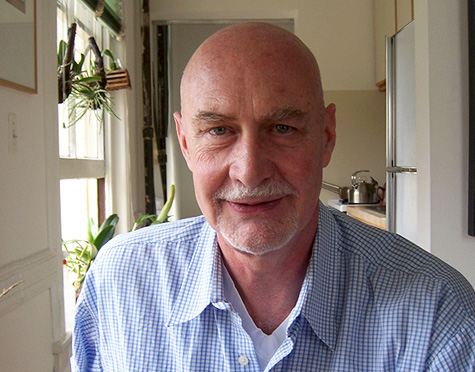Theme Essay by Emily Boghossian
For College Students, Irony Rules—Except When It Doesn’t
The lecture hall for my art history class was windowless, yet the raw damp outside followed me in. Ordinarily, these Thursday afternoon lectures were to be endured, avoided even, but this one felt different. The straight rows of desks were crowded with spectators. I saw tapping feet, heard nervous laughs.
The slide projector, a relic from the last century, cranked up. A photo from Yayoi Kusama's "The Anatomic Explosion" performance happening in 1968 flashed onto the screen. Ribby young people danced nude near the New York Stock Exchange. The black-and-white image silenced the room—but it wasn’t what we were there for.
Next to me, a fellow student’s blue jacket dripped puddles onto the linoleum. Andrew (not his real name) was a film major. Whenever he piped up in class, he liked to remind us that his knowledge of cinema was no less than encyclopedic.
Andrew leaned in now. “When do you think he’ll cry?”
I shrugged him off, but fooled no one. We were all wondering the same thing.

Our professor, Ross Elfline, had a tendency to pepper his lectures with expletives. At six-foot-four, he was formidable, with his tattooed arms, his passion for unbuildable architecture. We loved the tats and the cursing, of course, yet a more specific kind of voyeurism, one I’m still not proud of, attracted a mixed bag of humanities students to his Carleton College course every year.
If you enrolled in "Art Since 1945" and stuck it out through minimalist sculpture and Rauschenberg’s all-white paintings, through Yoko Ono's screaming performances and the wasteland that's video art, not only would Ross—we called him by his first name—bully you into enjoying some percentage of contemporary art; rumor had it he’d shed actual tears during his lecture on “Art and Activism.”
Since the first day of class, we’d been anticipating this lecture with all the ugly enthusiasm of a third grade field trip attending feeding time at the aquarium. It isn’t often you get to press your nose up to the glass, looking on as a fellow being emotes openly. Tears! How exotic.
But when Ross announced that the final thirty minutes of this lecture would be devoted to queer art critic Douglas Crimp, my faith in the art history rumor mill wavered. Who, with the whole of contemporary art before them, would misuse their tears on criticism—lovely and smart and striking as it could be?
I do enjoy criticism. I’m an English major and staunch bibliophile with a dorky interest in theory. But I don’t inhale the smell of a Harold Bloom essay with ecstatic longing or shudder on reaching the final paragraphs of Frank Kermode’s “Secrets and Narrative Sequence.” For me, such essays don’t produce the same pleasure-inducing chemicals that kick in mid-Joyce.
It’s hard to imagine one of my college peers getting a Michiko Kakutani book review tattooed on his upper calf. The inability to connect with such critics may well be a tic of my generation. Criticism is our default mode. The kneejerk need to maintain ironic distance requires us to strenuously avoid taking a stand for or against anything. We expect every truth to hide some dark underbelly, every sacred idol to sport feet of clay. In a world of snark, a craftily phrased put-down is more highly valued than a reasoned treatment of artistic shortfalls.
 And yet, that afternoon last November, sneakers sopping from a drippy Minnesota day, my knuckles clenched white when Ross clicked to a slide of the cover of October journal’s 1987 AIDS issue. In 2013, as I listened to a professor who must have been about my age in the mid-1980s, I got my first inklings that criticism could be visceral and daring. Maybe it could mean as much to readers as the art on which it feeds. Maybe I’d missed something vital, something worth seeking out in my own life.
And yet, that afternoon last November, sneakers sopping from a drippy Minnesota day, my knuckles clenched white when Ross clicked to a slide of the cover of October journal’s 1987 AIDS issue. In 2013, as I listened to a professor who must have been about my age in the mid-1980s, I got my first inklings that criticism could be visceral and daring. Maybe it could mean as much to readers as the art on which it feeds. Maybe I’d missed something vital, something worth seeking out in my own life.
In brief, Ross told the story of Crimp’s dramatic leap away from the usual critical approach to discussing art. In 1986, Crimp, a prominent writer and critic for October, asked his colleagues if he could put together a special issue on the AIDS crisis. That issue hit the shelves a year later.
In his essay for it, “AIDS: Cultural Analysis/Cultural Activism,” Crimp cited 25,644 known U.S. deaths from the disease alone. At the same time, President Reagan had only just begun to acknowledge the existence of AIDS. Crimp demanded that the art world, October included, crawl out from behind its bylines, exit the clean white cube of the gallery, and step into a new landscape upended by hate and misunderstanding:
Raising money is the most passive response of cultural practitioners to social crisis, a response that perpetuates the idea that art itself has no social function (aside from being a commodity), that there is no such thing as an engaged, activist aesthetic practice.
These were charged words for Crimp’s elite peers. Many of his coeditors at October were upset at being implicated by this impassioned call for activism and shocked by the anger and militancy of groups like ACT UP (AIDS Coalition to Unleash Power).
In 1990, when Crimp organized another issue called “How Do I Look? Queer Film and Video,” based on a set of conference papers that had already been accepted, it was barred from publication by a shaken editorial board. Other members were eager for October to reclaim its place as a high-modernist art journal that only reviewed works from a critical distance.
That year, Crimp split with the prestigious magazine. As a gay man and member of ACT UP, he made clear that artists and critics alike need to dirty their hands, tacking up posters such as “Silence=Death,” protesting at the tops of their voices.
 Months after Ross’s lecture, I don’t recall his exact words at this point in the Crimp story, but I’ve reconstructed the urgency of them from my notes:
Months after Ross’s lecture, I don’t recall his exact words at this point in the Crimp story, but I’ve reconstructed the urgency of them from my notes:
This is the true role of avant-garde art: to address the shocking and sometimes difficult realities of contemporary life, leaving the old garde to follow anemically in its wake. Crimp was like this big hot blast of light in the middle of a dark room—a signal to us all.
As Ross’s voice picked up speed, as the projector's click-clicking accelerated, I was sure I knew how this lecture would end: Our professor would spur us to action, begging our generation to locate an issue and take a stand.
But abruptly, he stopped short. The room was utterly still—still in the way a college classroom rarely is.
“Listen,” Ross said. “I’m going to show my cards. I was a member of ACT UP in the ‘90s. I was angry, I’m still angry, and I stand with Crimp. I will never submit my work to October. I can’t.”
It’s rare for a professor to make himself so vulnerable. God forbid my political science TA let slip that he’s pro-choice or my English professor admit she has a concealed-carry license. When tears formed in the corners of Ross’s eyes and his voice broke, I was awake. I sat forward in my seat. Even Andrew was silent.
After the lecture, I walked through the cold, wet afternoon, circumnavigating the Carleton campus until the green-gray November sky dulled into semidarkness. I stood behind the library, shedding quiet tears of my own.
These were shallow tears, I know. I was feeling painfully young, nostalgic for things I had never experienced. I understood and was moved by Ross’s story. Crimp had been unusually brave; he was and continues to be an important critical writer. In 2003, he told an Art Journal interviewer:
[M]y commitment to thinking about works of art comes from activist politics. To be able to inform one with the other and to see them as part of something larger is what matters to me.
Yet, I was unable to connect viscerally with Crimp’s criticism. I didn’t have Ross’s love of the subject. Why couldn’t I weep over my keyboard in response to some millennial literary critic toiling in the trenches? Instead, the English major and I seemed to be drifting farther apart. I feared that I was a daily disappointment. Some days, we were strangers, with only our mutual friends, the books, in common.
 A self-pitying walk, indeed. But beneath an overhang behind the library, I realized I did feel for Ross, my brave and worship-worthy teacher, in much the same way he felt for Crimp. Prepared to watch and joke with Andrew about an old-school display of emotion, I’d been ambushed by the real thing. I’d experienced my first Crimp, and it rocked me to my core.
A self-pitying walk, indeed. But beneath an overhang behind the library, I realized I did feel for Ross, my brave and worship-worthy teacher, in much the same way he felt for Crimp. Prepared to watch and joke with Andrew about an old-school display of emotion, I’d been ambushed by the real thing. I’d experienced my first Crimp, and it rocked me to my core.
We inherit our passions—perhaps from critics like Douglas Crimp, who challenge the art world publically and on personal grounds—perhaps from professors like Ross, who are unafraid to lay themselves bare before a small group of students who may not have done the reading. But the inheritance always comes from those with an unconditional love of their subject and the belief that it can do more.
“That’s it for today,” Ross said.
He dismissed us curtly, powering down the antique projector. I remember looking at the other students, who seemed just as speechless as I was, as confused about whether to file silently out of the lecture hall or to rise to their feet in applause.
I didn’t recognize it then—that deeply felt hum of admiration and tenderness in the presence of a courageous critic—but I do now.
Publishing Information
- "AIDS: Cultural Analysis/Cultural Activism" by Douglas Crimp, October, Winter 1987.
- “Front Room—Back Room: An Interview with Douglas Crimp” by Mathias Danbolt, Trikster #2, 2008.
- How Do I Look? Queer Film and Video, anthology edited by Bad Object-Choices (Bay Press, 1991).
- "The Melancholia of AIDS: Interview with Douglas Crimp" by Tina Takemoto, Art Journal, Winter 2003.
Art Information
- "A Section of the Berlin Wall with Graffiti Regarding ACT UP" (from the Newseum in Washington, D.C., August 2008) © Queerbubbles; Creative Commons license.
- "The Anatomic Explosion, Happening" (1968, in front of the statue of George Washington across from the New York Stock Exchange, New York) © Yayoi Kusama; used by permission.
- Photo of Douglas Crimp in ACT UP shirt © Douglas Crimp; used by permission.
- Trikster Photo of Douglas Crimp (2008) © Mathias Danbolt; used by permission.
- "A Pink Triangle Against a Black Backdrop with the Words 'Silence=Death'" (color lithograph, 1987) @ ACT UP; used by permission.
 Emily Boghossian has worked as a social media intern for Talking Writing. She is a senior English major at Carleton College in Minnesota. Podcasts currently eat up all of the space on her phone.
Emily Boghossian has worked as a social media intern for Talking Writing. She is a senior English major at Carleton College in Minnesota. Podcasts currently eat up all of the space on her phone.
